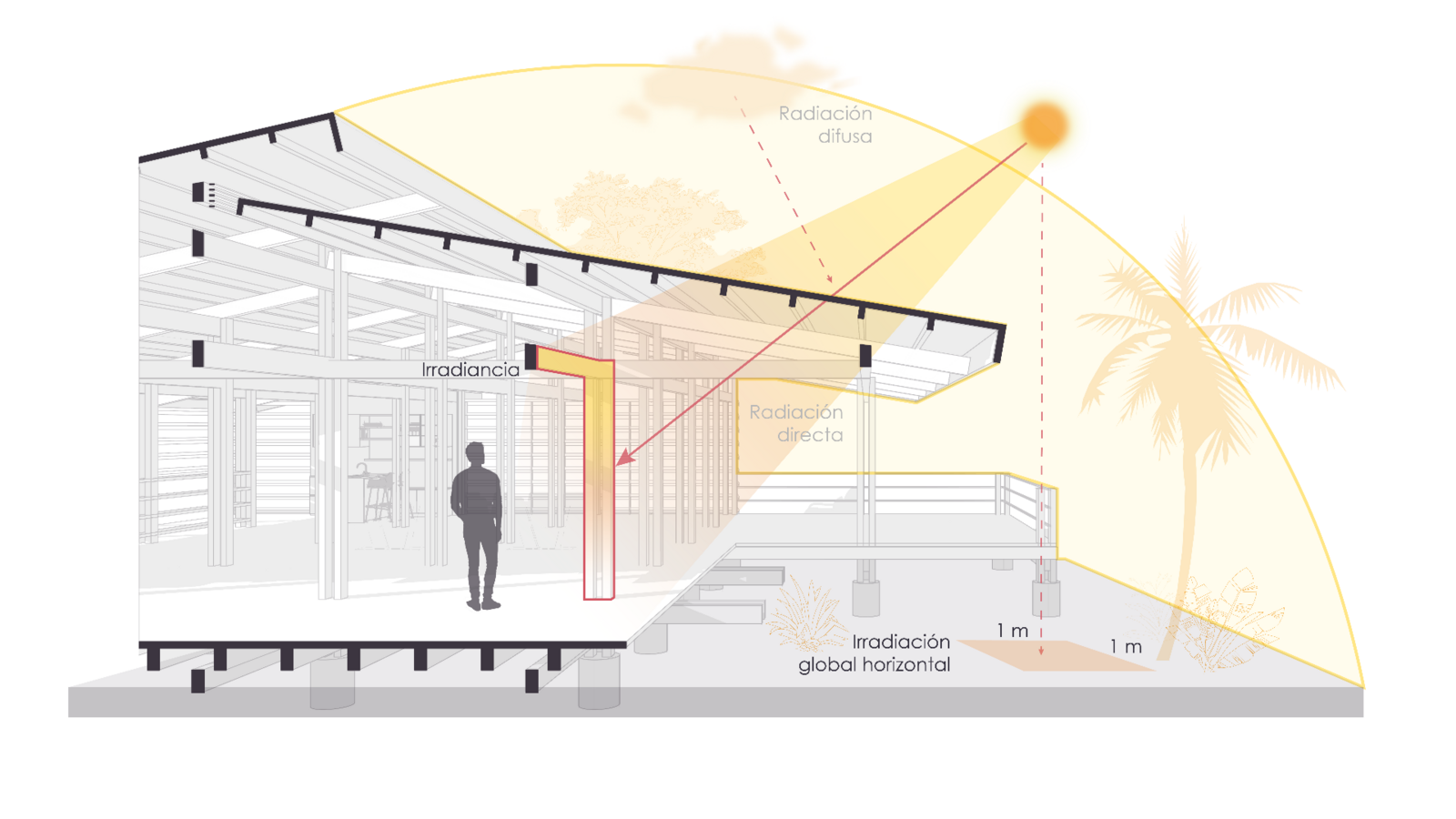Radiancia
Brownson, J. R. S. (2014) menciona que ”Resplandor: flujo radiante emitido por una superficie fuente por unidad de ángulo sólido [W/m2 sr]. Densidad de intensidad radiante con respecto al área proyectada en una dirección especificada en un punto especificado de una superficie real o imaginaria”.
Brownson, J. R. S. (2014) mentions that “Radiance: radiant flux emitted by a source surface per unit solid angle [W/m2 sr]. Radiant intensity density with respect to projected area in a specified direction at a specified point on a real or imaginary surface.”
Irradiancia
Irradiance
La comisión Nacional de Iluminación (2004), menciona que la irradiancia es “el Flujo radiante (potencia) incidente sobre una superficie [W/m2]”.
The National Lighting Commission (2004) mentions that irradiance is “the radiant flux (power) incident on a surface [W/m2]”.
Irradiancia Global Horizontal
Global Horizontal Irradiance
Brownson, J. R. S. (2014) menciona que “La irradiancia horizontal global (GHI) es la cantidad de irradiancia terrestre que incide sobre una superficie horizontal a la superficie de la Tierra. La GHI puede medirse con diversos instrumentos. El instrumento más utilizado para medir la GHI es el piranómetro, que tiene un ángulo de visión hemisférico (180°)”.
Brownson, J. R. S. (2014) mentions that “Global horizontal irradiance (GHI) is the amount of terrestrial irradiance incident on a surface horizontal to the Earth's surface. GHI can be measured with various instruments. The most commonly used instrument to measure GHI is the pyranometer, which has a hemispherical viewing angle (180°).”
Radiación Difusa
Difusse Radiation
Sandia National Laboratories.
(n.d.) menciona que “La radiación difusa es la luz solar remanente
y la redirigida debido a varios factores que ocurren en la
atmósfera:
1. Reflexión: La luz solar es reflejada por la propia atmósfera o
por las nubes antes de alcanzar la superficie terrestre.
2. Absorción: Las moléculas como el O2, O3, H2O, CO2, etc., se
excitan en determinadas longitudes de onda, lo que provoca que
absorban partes de la radiación, dando lugar a «huecos» o caídas en
el espectro.
3. Dispersión: Si la luz incide sobre determinados objetos,
dependiendo de la longitud de onda de la luz (λ) y del tamaño del
objeto, pueden producirse dos tipos principales de dispersión: (1)
dispersión Rayleigh (objetos menores que λ) y (2) dispersión Mie
(objetos mayores que λ, como polvos y aerosoles)”.
Sandia National Laboratories (n.d.) mentions that
“The diffuse radiation is the remaining and the redirected sunlight
due to several factors occurring in the atmosphere:
1. Reflection: Sunlight gets reflected either by the atmosphere
itself or by the clouds before reaching the earth’s surface.
2. Absorption: Molecules like O2, O3, H2O, CO2, etc., get excited
at certain wavelengths causing them to absorb parts of the
radiation, leading to “gaps” or drops in the spectrum.
3. Scattering: If light falls on certain objects, then depending on
the light’s wavelength (λ) and the object size, two main types of
scattering might occur: (1) Rayleigh scattering (objects smaller
than λ) and (2) Mie scattering (objects larger than λ, like dusts
and aerosols)”.
Radiación Directa
Direct Radiation
Sørensen, B. (2017) menciona que ”La radiación directa se define como la radiación que no ha experimentado dispersión en la atmósfera, por lo que es direccionalmente fija, procedente del disco del Sol”.
Sørensen, B. (2017) mentions that “Direct radiation is defined as radiation that has not experienced scattering in the atmosphere and is therefore directionally fixed, coming from the Sun's disk.”
Referencia:
Brownson, J. R. S.
(2014). Laws of Light. In Solar Energy Conversion Systems (pp.
41–66). Elsevier.
https://doi.org/10.1016/b978-0-12-397021-3.00003-x
-International
Commission on Illumination. (2004). ISO 15469:2004(E)/CIE S
011/E:2003. CIE. Retrieved February 6, 2025, from
https://cie.co.at/eilvterm/17-21-049
Sandia National Laboratories. (n.d.). PV performance modeling
collaborative: Global horizontal irradiance (GHI). Retrieved
February 6, 2025, from
https://pvpmc.sandia.gov/modeling-guide/1-weather-design-inputs/irradiance-insolation/global-horizontal-irradiance/
Rabaia, M. K. H., Olabi, A. G., Abdelkareem, M. A., & Sayed, E. T.
(2023). Introduction and definition of solar energy. In Renewable
Energy - Volume 1: Solar, Wind, and Hydropower Definitions,
Developments, Applications, Case Studies, and Modelling and
Simulation (Vol. 1, pp. 157–173).
Elsevier. https://doi.org/10.1016/B978-0-323-99568-9.00015-7
Sørensen, B. (2017). Origin of renewable energy
flows. In Renewable Energy (pp. 39–218).
Elsevier. https://doi.org/10.1016/b978-0-12-804567-1.00002-5
Conceptos relacionados:

